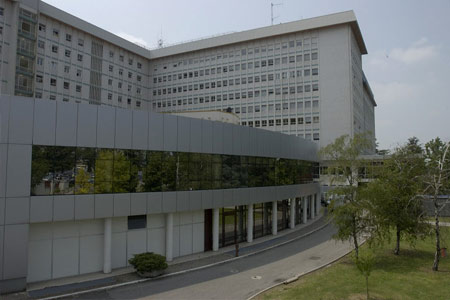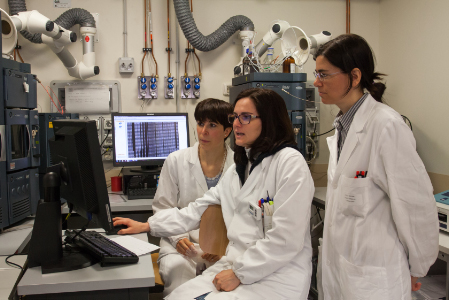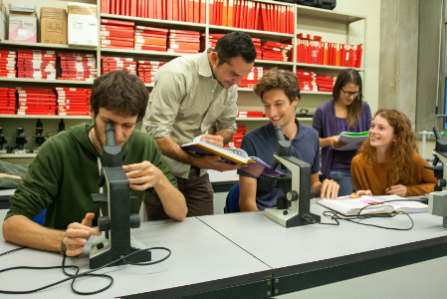The aim of the experiments that we are going to perform is to elucidate some unknown or not well clarified aspects regarding the mechanisms of expression of NADPH oxidase components in monocytes, macrophages and dendritic cells. The experimental model will be the following one: human monocytes will be isolated from the blood of healthy donors through Percoll gradient, put in culture and let to differentiate into macrophages in the presence or absence of various combinations of cytokines and/or chemokines (for instance proinflammatory cytokines such as TNF-alpha, IFN-gamma, IL-1, anti-inflammatory cytokines such as IL-4, IL-10, IL-13, chemokines such as IL-8, MCP, MIP, RANTES, as well as cytokines inducing the differentiation of monocytes into dendritic cells (for instance IL-4+GM-CSF, or IL-13+GM-CSF). At various stages of differentiation (i.e. at various times of culture), cell nuclei will be isolated and the association of the various transcription factors to the promoters of the genes encoding the NADPH oxidase components will be investigated by gel-shift assays (EMSA) with specific radiolabeled oligonucleotides reproducing the most important regions of such promoters. The protein components of the various complexes detected by such experiments will be identified through supershift assays with specific antibodies or competition assays by using unlabeled oligonucleotides containing or not mutations on the consensus sequences of the various transcription factors (for instance PU.1, CP-1, CDP, IRF-1, IRF-2, YY1, Elf-1). These experiments, together with further gel-shift assays performed with the addition of an excess of recombinant transcription regulators to the nuclear extracts, will allow us to understand the influence of each protein on the formation of the different complexes bound to DNA. In parallel the following investigations will be performed: v1)Analysis of signal transduction pathways involved either in the association between DNA and transcription factors as well as in the interaction among different transcription factors leading to formation of the varius complexes identified by gel shift experiments.vTo this purpose, before the gel shift and super shift experiments, the cells will be cultured with or without cytokines following the above-described model, and with or without general inhibitors of serine-threonine kinase (Staurosporine), of tyrosine kinases (genistein) or of phosphatase (okadaic acid, vanadate, calyculin A). Moreover, the signaling pathways involved will be analyzed by using more selective inhibitors, such as wortmannin and LY294002 (phosphatidylinositol 3-OH kinase inhibitors), SB203580, PD098059, PD184352 (MAP-kinase inhibitors), Daidzein and Emodin (casein kinase II inhibitors), chelerythrine chloride, Go6976 and Go6850(protein kinase C inhibitors). Signaling events will be further analyzed by means of the following three experimental approaches: a)analysis of cells from Fgr and Hck tyrosine kinase knock-out mice ; b) analysis of the effect of myristoilated peptides (able to accumulate on the inner surface of the plasma membrane)with sequences derived from pseudo substrate regions of different isoforms of protein kinase C ðað,ð ðdð,ð ðeð,ð ðzð)ircences derived from Antennapedia (a Drosophila transcription factor) and with cargoes sequences derived from specific effector regions of the small GTP-binding proteins H-ras (aa. 19-41) and RhoA (aa. 23-40 e 95-119). These last two approaches will allow a selective analysis without the necessity of cell transfection; furthermore, in case of trojan peptides from H-Ras and RhoA, these approaches will allow the study of important functional domains of these molecules in the chosen experimental context. Synthetic myristoilated peptides have been already published (Laudanna et al., JBC 1998) and are available; trojan peptides will be either produced as recombinant proteins(expressed and purified from bacteria)(RhoA-derived peptides are already available)as well as synthetic peptides.vThese experiments will be then completed by immunoprecipitation assays of transcription factors selected also in this case on the basis of the results of the above experiments and following immunoblotting with anti-phosphotyrosine or anti-phosphoserine antibodies, and by in vitro kinase assays carried out by addition of substrates of protein kinases (for instance dephosphorylated casein, histones, MAP-kinases) to the cell lysates in the presence of radiolabeled ATP. Other experiments will be performed by using monocytes kept in suspension (i.e. cultured in teflon dishes) to understand the role of cell adhesion to the wells in each result obtained.v We are also going to perform gel-shift or supershift experiments in the presence of reducing (for instance dithiothreitol) or oxidizing (for instance H2O2) agents, or after cell culture in the presence of flavoprotein inhibitors (for instance Diphenylene iodonium) to investigate the role of oxidoreductive reactions in the activation of the transcription factors examined. These studies are particularly relevant considering that the enzyme analysed is an oxidase, that could therefore self-regulate its own activity and expression in dependence on the amount of oxygen free radicals produced. To this purpose we would like to also perform experiments with cells from patients affected by Chronic Granulomatous Disease, whose leukocytes do not produce oxygen free radicals, and that are therefore very useful to understand the role of the radicals in various processes.
All the above-mentioned experiments will be also performed in parallel by using myeloid cell lines (U937, HL60...) expressing or not the NADPH oxidase as well as with cells that express the NADPH oxidase at much lower levels than phagocytes, such as fibroblasts or B lymphocytes, to understand whether in these cells the mechanisms of NADPH oxidase expression are similar or not to those observed in monocytes and macrophages.
2) Functional assays performed by cell permeabilization and insertion of oligonucleotides (or antibodies) blocking selected transcription factors, or by using phosphorothioate oligonucleotides crossing the plasma membrane as competitors. Once obtained the inhibition of selected transcription factors in whole cells we will perform: 1) spectrophotometric measurements of superoxide anion production in response to phorbol esthers (PMA) stimulation, 2) Western and Northern blots to detect the changes of expression of the various NADPH oxidase components in terms of mRNA and proteins. These experiments will be carried out in monocytes and macrophages at various degrees of differentiation and treated or not with cytokines, and will clarify which transcription factors are involved in the spontaneous decline of the activity of the enzyme during the differentiation of monocytes into macrophages, in its responsiveness to the cytokines, as well as in the expression of some NADPH oxidase components.







